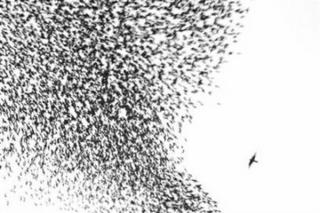As I completed my list of Ten Epiphanous Photographs, with Josef Sudek's At the Janacek's being the tenth and last selection, I was reminded by Sudek's Kafkaesque-like imagery that I have recently been lucky enough to capture an image that would (I think) do Kafka proud...

The image was taken a few weeks ago at Forest Glen, Maryland, a wonderful "park" that consists of acre-upon-acre of old, abandoned buildings that (dating back to the 1880s) were used, in turn, for a tobacco plantation, a hotel, the Norfolk College for Young Women, a seminary, and, in 1942, an Annex of Walter Reed Army Medical Center.
Today, the estate is essentially a relic, but is soon to be renovated. For photographers (particularly those whose "eye" leans toward the beauty of entropic decay;-) it is a veritable paradise for a weekend safari.
What went through my mind as I encountered this marvelous site (sandwitched atop two buildings on the portion of the estate closest to the main road) was Franz Kafka's parable, "Before the Law" (or, more precisely, what the door in this parable will look like, years and years after the events in the parable have taken place)...
"Before the law sits a gatekeeper. To this gatekeeper comes a man from the country who asks to gain entry into the law. But the gatekeeper says that he cannot grant him entry at the moment. The man thinks about it and then asks if he will be allowed to come in later on. “It is possible,” says the gatekeeper, “but not now.” At the moment the gate to the law stands open, as always, and the gatekeeper walks to the side, so the man bends over in order to see through the gate into the inside. When the gatekeeper notices that, he laughs and says: “If it tempts you so much, try it in spite of my prohibition. But take note: I am powerful. And I am only the most lowly gatekeeper. But from room to room stand gatekeepers, each more powerful than the other. I can’t endure even one glimpse of the third....
...During the many years the man observes the gatekeeper almost continuously. He forgets the other gatekeepers, and this one seems to him the only obstacle for entry into the law...
...Finally his eyesight grows weak, and he does not know whether things are really darker around him or whether his eyes are merely deceiving him. But he recognizes now in the darkness an illumination which breaks inextinguishably out of the gateway to the law...Before his death he gathers in his head all his experiences of the entire time up into one question which he has not yet put to the gatekeeper...
...“Everyone strives after the law,” says the man, “so how is that in these many years no one except me has requested entry?” The gatekeeper sees that the man is already dying and, in order to reach his diminishing sense of hearing, he shouts at him, “Here no one else can gain entry, since this entrance was assigned only to you. I’m going now to close it.”
The viewer certainly doesn't have to (or need to) know what goes through the photographer's mind the instant the shutter is pressed, but it is hard to look at some images in any way other than how the photographer envisioned it after being told what that vision was! I thus present to you, gentle reader and viewer, what can henceforth be seen only as Kafka's Door!



